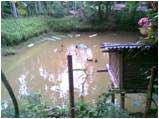 Farmers of the 11 villages in the South Garo Hills district in north-eastern region have upgraded their livelihood through scientific farm practices and other technological interventions. Moreover, allied poultry, piggery, duckery and sustainable water management wooed farmers adding extra income to their pockets. This could become possible due to all-round support of the ICAR Research Complex for NEH Region, Barapani under the NAIP project for livelihood security.
Farmers of the 11 villages in the South Garo Hills district in north-eastern region have upgraded their livelihood through scientific farm practices and other technological interventions. Moreover, allied poultry, piggery, duckery and sustainable water management wooed farmers adding extra income to their pockets. This could become possible due to all-round support of the ICAR Research Complex for NEH Region, Barapani under the NAIP project for livelihood security.
With the appropriate technology input, rice cultivated through SRI (System of Rice Intensification) recorded 4.8 tonne/ha over the conventionally practiced 1.5 tonne/ha. High yields were recorded at Shivbari, Diphalipara, Konkana and Jadugiri and seven villages bordering with Bangladesh, which the NAIP had selected for rice improvements. Now, most of these villages cultivate rice with SRI with their own success stories.

After three years of hard work across the farmers’ fields, the most backward and deprived farmers became “progressive farmers’ due to enhanced awareness and technology empowerment. “Twenty Seven quintals of rice from just an acre only is like a miracle! We have never-ever got such bumper rice yielding from a little chunk of land throughout our life,” said school teacher turned farmer, Mahendra Hagen of Pipalipara village. My paddy cultivation provided the maximum acreage by using SRI-applications. Moreover, my work has been widely recognized across the area, he added further.
Farmers choice of profession is a key step to develop entrepreneurial attitude, however land holding is also crucial. Those who have lands can go for better crops while those who do not have can opt for goatery, piggery and tailoring.
“I am supplying fingerlings worth Rs.100, 000 across South Garo Hills every year. However, most of the time, the fingerlings demand is so high that I could not meet the supply orders. This is so because the upsurging demands are coming either from the district or outside. For the current year, I sold fingerlings worth Rs 60,000 from just a half acre of pond so far. The supply orders will be met shortly”, said progressive farmer, Wildstone Sangama, possessing 50 acres of land at village Diphalipara.
“Duckery can be a profitable business for small and even landless farmers because it requires little space and feed”, says Pushpanjali of Diphalipara village. She further added that maintaining duckery at your courtyard is as simple as rearing any pets. Moreover, just spend two laborious years initially after which the first crop of the duckery will gleam you with the confidence that you can do it very easily.
Umran based Regional Rural Training Center (RRTC), an NGO, equally partnered with the NAIP Project, is also working with these bordering villages for quite a long time. So far, the results are satisfactory.
(Source: NAIP Sub-Project on Mass Media Mobilization, DKMA with inputs from the ICAR Research Complex for NEH Region, Barapani )








Like on Facebook
Subscribe on Youtube
Follow on X X
Like on instagram